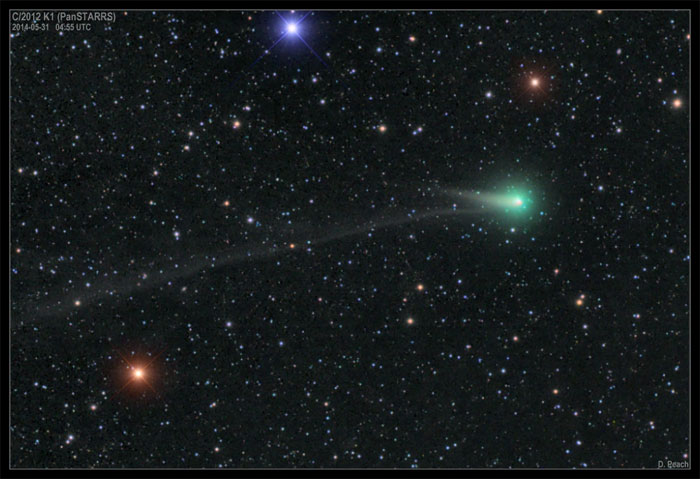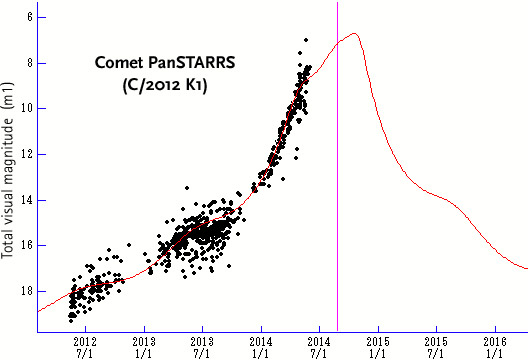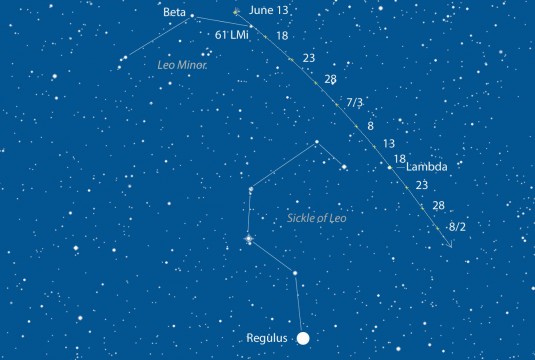.
2.06.2014
COMET PANSTARRS K1: On August 27, 2014, Comet C/2012 K1 PanSTARRS will buzz Earth's orbit only 0.05 AU away. Unfortunately for sky watchers, Earth won't be there. Our planet will be on the other side of the sun during PanSTARRS's close approach. A better time to photograph the comet is now. UK astronomer Damian Peach took this picture from his backyard observatory in Selsey, West Sussex, on May 31st:
.

His picture highlights the comet's vivid green atmosphere or "coma". The verdant hue is a sign of diatomic carbon and cyanogen, two gases that grow green when illuminated by sunligght in the near-vacuum of space.
"The comet's long ion tail is still rather faint," notes Peach. To pull it out of the starry background required a 30 minute exposure with his 4-inch telecope.
PanSTARRS K1 is currently moving through Ursa Major, shining about as brightly as an 8th magnitude star. This makes it an easy target for mid-sized backyard telescopes, albeit invisible to the naked eye. Amateur astronomers who wish to image the comet can find orbital elements and an ephemeris here.
If Earth and the comet were on the same side of the sun in August, the view would be spectacular. Disappointment will be mitigated, only a little, by images from the Solar and Heliospheric Observatory. SOHO's C3 coronagraph will track the comet as it passes behind the sun (from our point of view) from August 2nd until August 16th.
Quelle: Spaceweather
.
Update: 12.06.2014
.
Comet PanSTARRS Keeps Getting Better
.
With the Moon departing the early evening sky this weekend, eager skywatchers have a delightful prize before their eyes: Comet PanSTARRS (C/2012 K1). This reliable visitor seems as if it's been around forever. Well, not quite but almost.
That was then. C/2012 K1 has been fattening up on sunlight ever since. With its distance from the Sun shrinking from 8.7 astronomical units at discovery to 1.05 a.u. at its upcoming perihelion on August 27th, the comet has brightened to magnitude 8. This puts it within easy range of 50-mm binoculars from a dark-sky site.
I saw it a week ago with a simple pair of 8×40s as a blob of fuzzy light in the little constellation of Leo Minor. Through a 15-inch reflector at low magnification, C/2012 K1 displayed a bright, well-condensed coma swaddling a tiny, brighter nucleus. A lovely dust tail about ½° long extended to the east-northeast and seemed to flutter about according to the vagaries of averted vision. I could only detect a hint of the much fainter ion tail to the southeast.
.

Comet PanSTARRS (C/2012 K1) has brightened steadily since its discovery. The comet is expected to reach magnitude 6 or 7 magnitude in the fall, when it will be low in the morning sky for mid-northern latitude observers.
Seiichi Yoshida
.
Ready to have a look yourself? Face west at nightfall in the coming weeks and locate the familiar "backward question mark" asterism better known as the Sickle of Leo. The chart will help you star hop from there to the comet.
While not a spectacular sight in binoculars, I encourage you to go for it. Binocular comets are few and far between, and this one is worth the risk of a few mosquito bites on a summer night. Besides, the next few weeks will be the last chance for mid-northern observers to catch C/2012 K1 at a convenient time and relatively high altitude.
Come mid-July, the comet dips into the twilight glow and disappears from view. It returns to view, this time in the morning sky before dawn, in mid-September, but it won't climb much higher than 20° for mid-northern skywatchers while swinging south from Hydra into Puppis.
In theory, Comet PanSTARRS should continue to brighten over this months-long interval. Will it crest to naked-eye brightness as the leaves start to fall? I've got my fingers crossed!
.

Comet PanSTARRS (C/2012 K1) spends mid-June in Leo Minor near the 4.5-magnitude star 61 Leo Minoris before gliding over the Sickle of Leo, highlighted by the 1st-magnitude star Regulus. Comet positions are shown for 10:30 p.m. EDT every five days from June 13th through August 2nd. Click to enlarge and print out for use at the telescope.
Quelle: Sky&Telescope
4715 Views
